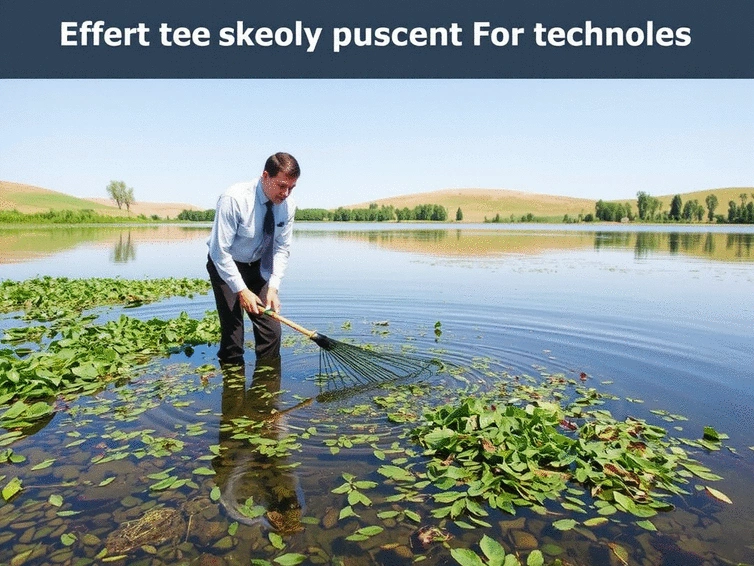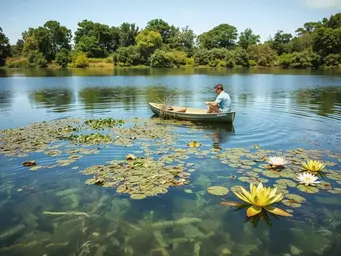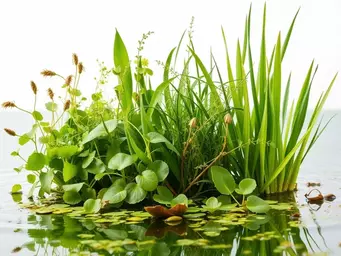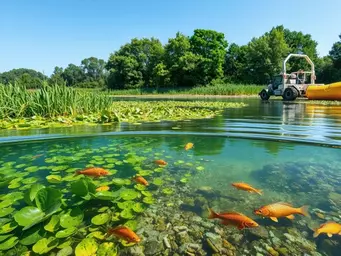
Effective Aquatic Weed Control Methods
Have you ever considered how a single invasive plant can disrupt an entire ecosystem? Understanding aquatic weed management is not just about control; it’s about preserving the delicate balance of our waterways. Let’s explore the essential insights that can empower you to take action.
What You Will Learn
- Identifying key invasive aquatic weed species is crucial for effective management.
- Invasive species can significantly impact biodiversity and alter water quality.
- Regular monitoring of water quality factors such as nutrient levels and pH is essential for controlling weed growth.
- Community involvement enhances stewardship and the effectiveness of management efforts.
- Implementing watershed management practices can address root causes of aquatic weed issues holistically.
Key Aspects of Aquatic Weed Management
Effective aquatic weed management relies on understanding key factors and implementing a structured process. This visual highlights the critical components and their interdependencies.
Understanding Aquatic Weeds
- ✓ Identification (e.g., Hydrilla, Water Hyacinth)
- ✓ Impact on ecosystems (biodiversity, water quality)
Crucial first step for effective control.
Water Quality Factors
- ✓ Nutrient levels (Phosphorus, Nitrogen)
- ✓ pH levels
- ✓ Temperature fluctuations
Directly influences weed growth and proliferation.
Sustainable Management Plan
- ✓ Regular monitoring & maintenance
- ✓ Community involvement
- ✓ Watershed management
Ensures long-term ecological balance and health.
Call to Action & Resources
- ✓ Utilize online guides & seminars
- ✓ Network with fellow stewards
- ✓ Contact local experts
Empowering proactive and informed decisions.
Understanding Aquatic Weed Management: The Importance of Effective Control Methods
When it comes to managing aquatic weeds, understanding their identification and control is crucial. Aquatic weeds can quickly take over ponds and lakes, leading to significant ecological imbalance. With my experience at Aquatic Weed Solutions, I've seen firsthand the importance of effective control methods in preserving our precious water ecosystems. Let's dive into the essentials of aquatic weed management!
Identifying Common Aquatic Weeds in Ponds and Lakes
Before we can manage aquatic weeds, we must first recognize the common species that inhabit our water bodies. Some prevalent aquatic weeds include:
- Hydrilla: A fast-growing invasive plant that can easily choke waterways.
- Water Hyacinth: Known for its beautiful flowers, this weed can double its biomass in just a few weeks!
- Curly-leaf Pondweed: A perennial that thrives in cooler waters and can disrupt local ecosystems. Learn more about its management and identification in this comprehensive guide from the Washington State Department of Ecology.
- Eurasian Watermilfoil: Another invasive species that can form dense mats on the water's surface.
Identifying these species is the first step to effective management. By recognizing their unique characteristics, you can take informed action to control their spread and restore balance to your waterways.

The Impact of Invasive Species on Ecosystems
Invasive species like those mentioned previously can disrupt the delicate balance of aquatic ecosystems. They outcompete native plants for resources, leading to a decrease in biodiversity and affecting water quality. Additionally, these invasive weeds can create habitats that are less favorable for fish and other aquatic organisms, altering the entire food web.
It's alarming to see how quickly a waterway can change when invasive species take hold. This highlights the necessity for proactive management to maintain healthy ecosystems. As stewards of our waterways, we must understand these impacts and strive to mitigate them. For further reading on aquatic pesticide application plans and their role in managing invasive species, you can refer to the U.S. Army Corps of Engineers' annual aquatic pesticide application plan.
Understanding Water Quality and Its Role in Aquatic Weed Management
Water quality plays a significant role in the growth and spread of aquatic weeds. Factors such as nutrient levels, pH, and temperature can influence weed proliferation. High nutrient levels, often due to runoff, can create an environment where invasive species thrive.
To effectively manage aquatic weeds, consider monitoring your water quality regularly. This can help you identify potential problems before they escalate. Here are some key aspects to evaluate:
- Nutrient concentrations: Test for phosphorus and nitrogen levels.
- pH levels: Ensure it remains within a suitable range for your local aquatic life.
- Temperature fluctuations: Keep an eye on seasonal changes that may encourage weed growth.
By understanding the relationship between water quality and aquatic weeds, we can implement more effective management strategies, ultimately fostering healthier aquatic environments.
Frequently Asked Questions About Aquatic Weed Management
What are the most common invasive aquatic weed species?
Some of the most prevalent invasive aquatic weeds include Hydrilla, Water Hyacinth, Curly-leaf Pondweed, and Eurasian Watermilfoil. Identifying these is crucial for effective management.
How do invasive aquatic weeds impact ecosystems?
Invasive species can disrupt the delicate balance of aquatic ecosystems by outcompeting native plants, decreasing biodiversity, altering water quality, and creating less favorable habitats for fish and other aquatic organisms.
What water quality factors influence aquatic weed growth?
Key water quality factors influencing weed proliferation include nutrient levels (phosphorus and nitrogen), pH levels, and temperature fluctuations. High nutrient levels often contribute to rapid weed growth.
Why is regular monitoring and maintenance important for aquatic weed management?
Regular monitoring and maintenance are essential for catching potential weed issues early, preventing them from escalating, and adapting management strategies to maintain a healthy aquatic ecosystem. This includes visual inspections, water quality testing, and tracking plant growth patterns.
How can community involvement help in aquatic weed management?
Engaging local residents and stakeholders significantly amplifies management efforts. Strategies include hosting educational workshops, organizing volunteer clean-up days, and forming community monitoring groups, fostering a sense of shared responsibility.
What is watershed management and how does it relate to aquatic weed control?
Watershed management involves considering the entire surrounding land area that drains into a waterway. By integrating practices such as promoting native vegetation, implementing erosion control, and collaborating to manage runoff, it addresses the root causes of aquatic weed issues for holistic ecosystem care.
Engage with Your Community!
How involved are you in your local aquatic stewardship efforts? Share your thoughts with us!
Conclusion: Crafting a Sustainable Aquatic Weed Management Plan
As we wrap up our discussion on aquatic weed management, it's clear that developing a sustainable plan is essential for preserving the health of our waterways. A well-crafted management plan not only addresses immediate concerns but also paves the way for long-term ecological balance. Remember, it’s about creating a thriving environment for both native species and local communities.
One key aspect of effective management is the importance of regular monitoring and maintenance. Keeping an eye on your waterway allows you to catch potential weed issues early, ensuring that they don’t escalate into larger problems. By routinely assessing your ponds and lakes, you can adapt your strategies as needed to maintain a healthy aquatic ecosystem.
The Importance of Regular Monitoring and Maintenance
Monitoring is more than just a periodic check-up; it’s an ongoing commitment to understanding the dynamics of your aquatic environment. Regular maintenance activities can include:
- Visual inspections of the water for signs of invasive species
- Sample testing for water quality indicators
- Tracking the growth patterns of native plants versus weeds
By incorporating these practices, you not only safeguard your aquatic habitat but also enhance your knowledge as a steward of the ecosystem. It’s empowering to see the positive changes that diligent care can bring!

Encouraging Community Involvement in Pond and Lake Stewardship
Community involvement is another cornerstone of sustainable aquatic weed management. Engaging local residents and stakeholders can significantly amplify your efforts. Here are some strategies to foster community participation:
- Host educational workshops on aquatic weed identification and management
- Organize volunteer clean-up days to involve the community in hands-on activities
- Create community monitoring groups to share responsibilities and insights
When everyone pitches in, the impact multiplies! I’ve seen firsthand the enthusiasm from community members when they take part in stewardship activities. It sparks a sense of pride and responsibility toward our shared waterways.
Implementing Watershed Management for Holistic Ecosystem Care
Lastly, integrating watershed management practices is crucial for holistic ecosystem care. By considering the entire watershed, we can address the root causes of aquatic weed issues more effectively. Here are some best practices to consider:
- Promote native vegetation in the watershed to improve water quality
- Implement erosion control measures to reduce sedimentation in lakes and ponds
- Collaborate with local organizations to manage runoff and pollution sources
As I’ve learned through my work at Aquatic Weed Solutions, taking a watershed approach not only benefits water quality but also supports the entire ecosystem. Together, these strategies create a comprehensive framework for managing our aquatic environments sustainably. For a detailed guide on managing aquatic weeds, including mechanical and chemical control methods, refer to this resource from New Mexico State University Extension.
Call to Action: Start Your Aquatic Weed Management Journey Today
Now that you have the tools and insights to develop a sustainable aquatic weed management plan, it’s time to take action! Whether you’re a landowner, an ecologist, or just someone passionate about your local waterways, I encourage you to start implementing these strategies today.
Resources for Effective Pond and Lake Management
To assist you on your journey, I have compiled a list of valuable resources:
- Online guides for species identification and management techniques
- Local workshops and seminars on aquatic ecosystem care
- Networking opportunities with fellow waterway stewards
These resources will not only enhance your knowledge but also connect you with others who share your passion for aquatic health!
Contact Local Experts for Personalized Guidance
Lastly, don’t hesitate to reach out to local experts for tailored advice. Experts like those at Aquatic Weed Solutions can provide personalized insights based on the specific conditions of your waterway. Working together, we can create a future where our aquatic ecosystems thrive!
Recap of Key Points
Here is a quick recap of the important points discussed in the article:
- Identify common aquatic weeds such as Hydrilla, Water Hyacinth, Curly-leaf Pondweed, and Eurasian Watermilfoil for effective management.
- Understand the impact of invasive species on ecosystems, including decreased biodiversity and altered water quality.
- Regularly monitor water quality factors like nutrient levels, pH, and temperature to manage aquatic weeds proactively.
- Develop a sustainable aquatic weed management plan that includes regular monitoring and community involvement.
- Implement watershed management practices to address the root causes of weed issues and promote ecological balance.





Managing Aquatic Weeds Effectively
Impact of Aquatic Weeds on Recreation
Understanding Aquatic Weed Varieties
Integrated Aquatic Weed Management Methods
Integrated Approaches to Aquatic Weeds